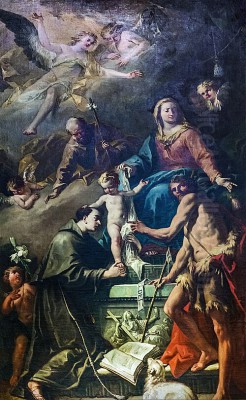
Gaspare Diziani stands as a significant figure in the vibrant artistic landscape of 18th-century Venice. Born in Belluno in 1689 and passing away in Venice in 1767, his life spanned a period of transition, witnessing the full flowering of the Late Baroque and the elegant rise of the Rococo style. Diziani was not merely a painter; he was a prolific decorator, a stage designer, and eventually a leader within the Venetian art community, leaving behind a vast body of work that reflects both the grandeur and the grace of his time. His artistic journey took him from the Venetian mainland to the heart of the Republic, and even extended his influence to prominent European courts, including those in Dresden and Munich.
Diziani's importance stems from his ability to synthesize the dramatic intensity of the Baroque with the lighter, more decorative sensibilities of the Rococo. He was a master of large-scale compositions, particularly frescoes and altarpieces, but also adept at smaller easel paintings and preparatory sketches. His work is characterized by dynamic compositions, a rich and often bold color palette, and a fluid, energetic brushstroke. Through his training, travels, and extensive commissions, Diziani became a key exponent of the Venetian school during its last great flourish.
Early Life and Artistic Formation
Gaspare Diziani's artistic path began in his hometown of Belluno, nestled in the foothills of the Dolomites. His initial training was under a local painter named Antonio Lazzarini. While this early instruction provided a foundation, the lure of Venice, the dominant artistic center of the region, proved irresistible for the ambitious young artist. Seeking more advanced training and greater opportunities, Diziani made the pivotal move to the lagoon city.
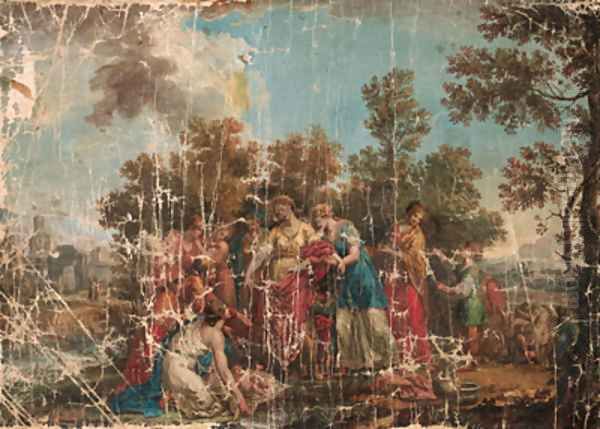
In Venice, Diziani entered the workshop of Gregorio Lazzarini. This was a significant step, as Gregorio Lazzarini (no direct relation to Antonio) was one of the most respected and successful painters in Venice at the time. His studio was renowned, attracting talented pupils, the most famous of whom would be Giambattista Tiepolo. Lazzarini was known for his academic rigor, his deep knowledge of mythology and history, and his insistence that his students master various stylistic approaches. Under his tutelage, Diziani would have received a thorough grounding in drawing, composition, and the established traditions of Venetian painting.
Following his time with Lazzarini, Diziani further honed his skills in the studio of Sebastiano Ricci. Ricci, who had absorbed international influences, particularly during his time in England, brought a brighter palette, a more fluid handling of paint, and a dynamic energy to Venetian art, effectively paving the way for the Rococo. Ricci's influence on Diziani was profound, evident in the younger artist's adoption of more vibrant colors, dramatic compositions, and a quicker, more spirited brushwork. This combination of Lazzarini's academic solidity and Ricci's dynamic flair equipped Diziani with the versatility and technical prowess that would define his long career.
Development of Style
Gaspare Diziani's mature style is a compelling blend of Late Baroque theatricality and Rococo elegance, deeply rooted in the Venetian tradition of colorito (emphasis on color and brushwork). His training under both Gregorio Lazzarini and Sebastiano Ricci provided him with a diverse toolkit, allowing him to adapt his approach depending on the commission's scale and subject matter. However, several key characteristics permeate his oeuvre.
A hallmark of Diziani's work is his bold and often rich use of color. Influenced by Ricci, he employed a vibrant palette, frequently featuring warm reds, golds, and blues, applied with a confidence that enlivens his canvases. He wasn't afraid of strong contrasts, using light and shadow (chiaroscuro) effectively to model forms, create depth, and enhance the dramatic impact of his scenes, particularly in his religious and historical narratives. This skillful manipulation of light imbues his figures and settings with a sense of volume and presence.
His brushwork is typically fluid, rapid, and energetic, often described as "lively" or "sketchy." This technique, particularly evident in his oil sketches (bozzetti) and drawings, lends an immediacy and dynamism to his work. It reflects the influence of Ricci and anticipates the painterly freedom characteristic of much 18th-century Venetian art. Even in large-scale finished works, this underlying energy is often palpable. Diziani was also noted for his skill as a draftsman, sometimes using red chalk or pencil for preparatory studies, which further showcased his confident hand and compositional thinking.
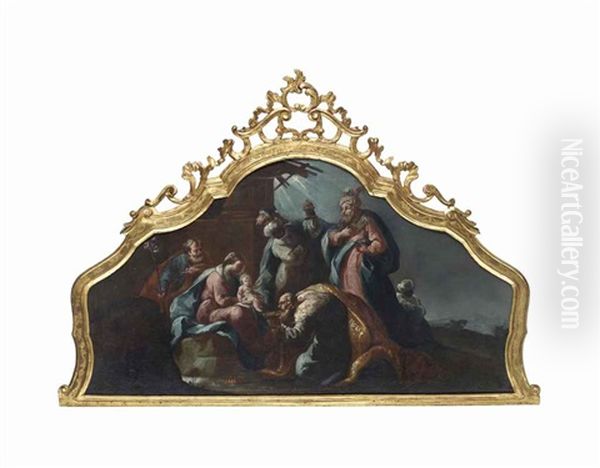
While capable of Baroque grandeur, Diziani's style also incorporates Rococo elements, such as lighter tones, more graceful figures in certain contexts, and a decorative sensibility, especially in his ceiling paintings and allegorical works. He navigated the stylistic currents of his time, producing works that could be powerfully dramatic or charmingly elegant, demonstrating a remarkable versatility that catered to the diverse demands of his patrons, from church officials to noble families.
Career Path and Major Commissions
Diziani's professional life began not primarily as an easel painter, but in the world of theatre. He initially gained experience designing stage scenery, an occupation that likely honed his skills in creating dramatic effects, handling large formats, and working quickly. During this phase, he is known to have collaborated with Alessandro Magnasco, a Genoese painter known for his highly individual, atmospheric style, suggesting Diziani was already moving within significant artistic circles.
Soon, however, Diziani transitioned more fully to painting, securing commissions for both religious institutions and private patrons. His early significant works, dating from the 1710s and 1720s, established his reputation. These included a series of eight paintings for the Church of Santo Stefano in Belluno and three significant frescoes depicting the life of Saint Helena for the Scuola del Santissimo Crocifisso, adjacent to the Church of San Domenico (now destroyed) in Venice. These projects demonstrated his ability to handle complex narratives and large-scale decorative schemes.
Diziani's talents attracted attention beyond Venice. He received commissions that took him abroad, notably to the court of the Elector of Saxony in Dresden and later to Munich for the Bavarian court. These engagements reflect his growing stature and the demand for skilled Venetian artists across Europe. Working in these courtly environments exposed him to different artistic trends and patronage systems, further broadening his experience.
A prestigious commission came in 1726 when he was called to Rome to execute decorative paintings for the Church of San Lorenzo in Damaso. This work was undertaken for Cardinal Pietro Ottoboni, a prominent patron of the arts. Working in Rome, even briefly, placed Diziani at the center of the Catholic world and allowed him to engage directly with the legacy of Roman Baroque art.
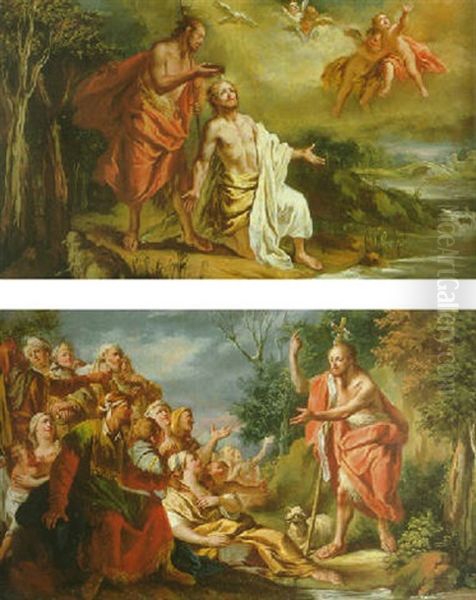
Despite these travels, Venice remained the primary center of Diziani's activity. He was highly productive, creating numerous altarpieces, ceiling paintings, and easel pictures for churches and palaces throughout the city and the surrounding Veneto region. Notable examples include frescoes for the Church of San Teodoro and the dramatic altarpiece depicting The Martyrdom of Saints Felix and Fortunatus for Chioggia Cathedral. His work adorned the homes of Venetian nobility, such as the decorative schemes in Ca' Rezzonico, showcasing his ability to create sophisticated allegorical and mythological scenes suited to palatial settings.
Representative Works: A Closer Look
Gaspare Diziani's extensive output includes many notable works that exemplify his style and thematic range. Examining a few key pieces reveals his artistic strengths and contributions.
Alexander the Great and Diogenes: This easel painting captures the famous encounter between the powerful conqueror and the ascetic philosopher. Diziani renders the scene with characteristic Baroque dynamism. The composition is lively, drawing the viewer into the dialogue. The use of warm, vibrant colors and strong contrasts of light and shadow enhances the narrative tension, highlighting the juxtaposition between worldly power (Alexander) and philosophical detachment (Diogenes). It showcases Diziani's skill in historical genre painting and his ability to convey psychological interaction.
The Finding of Moses: A popular biblical theme, Diziani's interpretation is notable for its rich coloration, detailed rendering, and skillful handling of light. The scene, often set in a lush landscape near the Nile, allowed Diziani to display his abilities in figure painting, landscape elements, and textile representation. The interplay of light on the figures and the water, combined with the emotional resonance of the discovery, makes this subject one he returned to, and his versions are often considered fine examples of his narrative skill within a Rococo-inflected Baroque framework. Some versions are highly regarded within his oeuvre.
The Martyrdom of Saints Felix and Fortunatus: Created as an altarpiece for the Cathedral in Chioggia, this work is a powerful example of Diziani's capacity for intense religious drama. The painting depicts the brutal martyrdom of the saints with unflinching directness. The composition is complex and agitated, filled with dynamic figures and strong emotional expressions. The use of dramatic lighting and forceful brushwork heightens the scene's violence and pathos. A preparatory oil sketch (bozzetto) for this work also survives, revealing Diziani's working process and his initial energetic conception of the composition, showcasing his mastery of light and form even in preliminary stages. The final work's intensity led some commentators to describe its style using terms like "mannerist" – not in the historical sense, but to denote its extreme expressiveness and stylization.
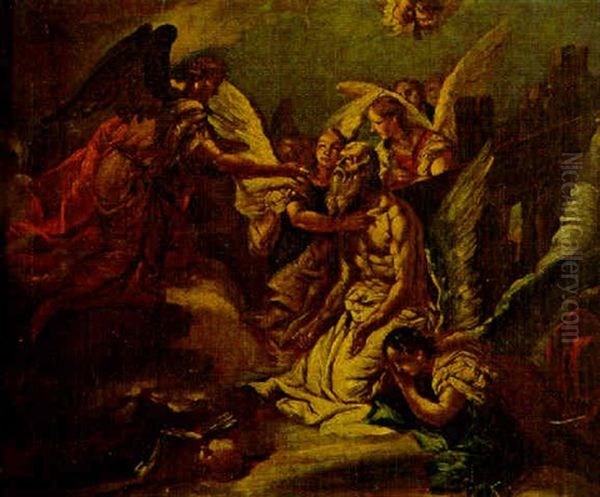
Art Overcoming Ignorance / The Triumph of Poetry: Diziani executed significant decorative frescoes for Venetian palaces, including Ca' Rezzonico (now a museum of 18th-century Venice). On the ceiling of the "Pastel Room," he painted an allegory often identified as Art Overcoming Ignorance or similar themes celebrating the arts. Another ceiling fresco in the palace is known as The Triumph of Poetry. These works are excellent examples of his decorative skill. Using illusionistic techniques (sotto in sù – "from below, upwards"), he created airy, light-filled compositions populated by allegorical figures floating against a sky background. The style here leans more towards the Rococo, with pastel shades, graceful figures, and an overall sense of lightness suitable for a domestic setting. These works, some of which have undergone restoration, demonstrate his importance in the decoration of Venetian noble residences.
The Canticle: While specifics might vary depending on the exact work referred to by this title, religious themes involving praise or divine inspiration were common for Diziani. Such works typically display his characteristic vibrant color, elegant compositional sense, and ability to convey spiritual feeling through expressive figures and dynamic arrangements, fitting seamlessly within the tradition of Venetian religious painting.
Contemporaries and Collaborations
Gaspare Diziani operated within a rich and competitive artistic milieu in 18th-century Venice. His career was shaped by his interactions with teachers, collaborators, contemporaries, and even his own artist sons. Understanding these connections helps place him within the broader context of the Venetian Settecento.
His most formative relationships were with his teachers, Gregorio Lazzarini and Sebastiano Ricci. From Lazzarini, he gained a solid academic foundation, while Ricci imparted a sense of dynamism, color, and painterly freedom that became central to Diziani's own style. He shared Lazzarini's studio, albeit likely at different times, with the slightly younger Giambattista Tiepolo, who would become the preeminent Venetian painter of the era. While their styles developed differently, they emerged from a similar training ground.
Early in his career, Diziani collaborated on stage designs with Alessandro Magnasco. This interaction highlights the fluidity between different artistic practices in the period and connects Diziani to a painter known for his unique, almost proto-Romantic style.
Diziani's work shows an awareness of other leading Venetian artists. He would certainly have known the work of figures like Francesco Piazzetta, known for his more tenebrist and emotionally resonant style, and Giambattista Pittoni, another prolific painter of religious and historical subjects often characterized by a brighter, Rococo palette. The influence of earlier Venetian masters, such as the great Giovanni Battista Tintoretto, known for his dramatic compositions and bold brushwork, can also be seen as part of the artistic heritage Diziani inherited and adapted. He likely interacted with Jacopo Amigoni, another Venetian who achieved international success, particularly with decorative Rococo schemes.
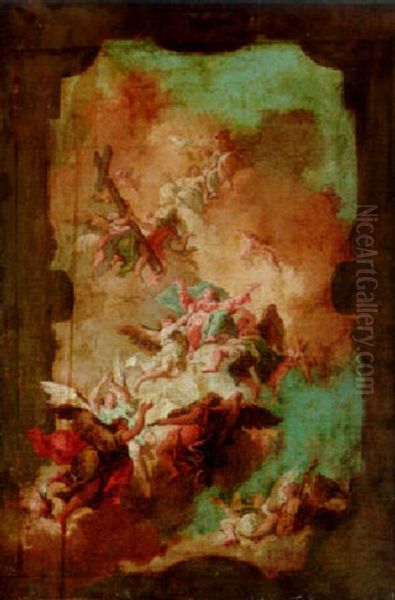
Furthermore, Diziani's artistic legacy extended through his family. Two of his sons, Antonio Diziani (known primarily for landscapes) and Giuseppe Diziani (who followed his father more closely in figure painting), also became painters. Antonio is sometimes listed as his pupil, and it's probable both sons assisted their father in his busy workshop, learning the trade and contributing to commissions, a common practice at the time. The engraver Giuseppe Camerata II also played a role in disseminating Diziani's compositions by creating prints after his designs, helping to spread his reputation.
These connections illustrate that Diziani was not an isolated figure but an active participant in the artistic life of Venice, learning from masters, influencing his peers and successors, and collaborating within the established workshop system.
Later Life and Legacy
Gaspare Diziani remained active as an artist well into his later years, continuing to receive commissions and maintain his workshop in Venice. His long career and consistent output solidified his position as one of the leading figures of the Venetian school in the mid-18th century. His dedication to his craft and his standing within the artistic community were formally recognized towards the end of his life.
In 1766, just a year before his death, Diziani was appointed President of the Venetian Academy of Fine Arts (Accademia di Belle Arti di Venezia). This was a prestigious honor, reflecting the high esteem in which he was held by his peers. Although his tenure was brief due to his advanced age and subsequent death, the appointment itself signifies his respected status as a senior master within the city's artistic establishment. The Academy played a crucial role in art education and upholding artistic standards in Venice.
Gaspare Diziani passed away in Venice in 1767. He left behind a significant artistic legacy, not only through his vast body of work scattered across churches, palaces, and museums in Venice, the Veneto, and internationally, but also through his influence on other artists, including his own sons, Antonio and Giuseppe, who carried on the family's artistic tradition, albeit with their own specializations.
In the grand narrative of art history, Diziani is recognized as a key figure of the Venetian Settecento. He successfully navigated the transition from the weighty drama of the Late Baroque to the lighter elegance of the Rococo, mastering both large-scale decorative fresco painting and smaller easel works across various genres – religious, historical, mythological, and allegorical. His reputation rests on his technical skill, particularly his vibrant use of color, his energetic brushwork, and his ability to create dynamic and engaging compositions.
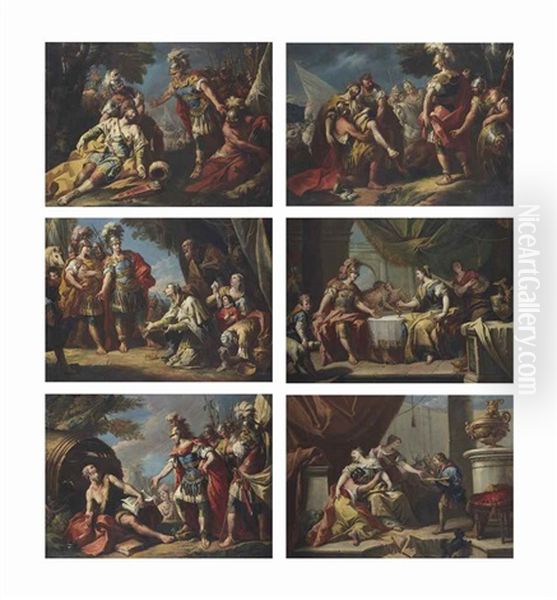
Many of Diziani's works survive today, though some, particularly frescoes, have suffered the effects of time, requiring careful restoration efforts, such as those undertaken at Ca' Rezzonico. His paintings and drawings are held in numerous major museum collections worldwide, allowing contemporary audiences to appreciate the skill and artistry of this prolific Venetian master. He remains an important representative of the final flourishing of history painting and large-scale decoration in the Republic of Venice before its fall.
Conclusion
Gaspare Diziani emerges from the annals of art history as a versatile, skilled, and highly productive painter who made significant contributions to the Venetian school during the Late Baroque and Rococo periods. From his foundational training under respected masters like Gregorio Lazzarini and Sebastiano Ricci to his extensive career encompassing stage design, church altarpieces, palace decorations, and international commissions, Diziani demonstrated a remarkable adaptability and enduring energy.
His artistic signature – characterized by bold color, dynamic compositions, and lively brushwork – allowed him to excel in both dramatic narratives and elegant allegories. He successfully bridged the stylistic gap between the grandeur of the Baroque and the decorative grace of the Rococo, reflecting the evolving tastes of his era. His work for churches, noble patrons, and European courts, alongside his eventual leadership role at the Venice Academy, underscores his importance within the 18th-century art world.
Though perhaps sometimes overshadowed by his contemporary Giambattista Tiepolo, Gaspare Diziani remains a crucial figure for understanding the richness and diversity of Venetian painting during its last great century. His legacy endures through the numerous works that survive in Venice and beyond, testaments to a long career dedicated to the vibrant traditions of Venetian art.